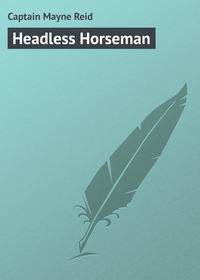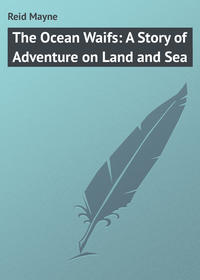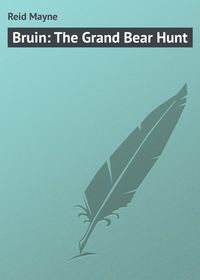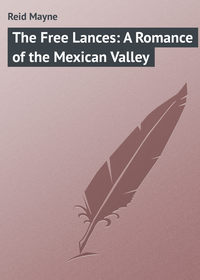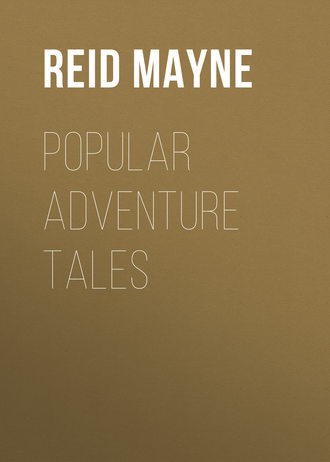 полная версия
полная версияPopular Adventure Tales
The red-head rarely interferes with either, as he is contented to feed upon the leaves and stalks, at all times floating in plenty upon the surface.
As the canoe glided near, those on board watched these curious manœuvres of the birds with feelings of interest. They saw, moreover, that the “trumpeter” had arrived among them, and the ducks seemed to take no notice of him. Lucien was struck with something unusual in the appearance of the swan. Its plumage seemed ruffled and on end, and it glided along in a stiff and unnatural manner. It moved its neck neither to one side nor the other, but held its head bent forward, until its bill almost touched the water, in the attitude that these birds adopt when feeding upon something near the surface. Lucien said nothing to his companions, as they were all silent, lest they might frighten the ducks; but Basil and Norman had also remarked the strange look and conduct of the trumpeter. François' eyes were bent only upon the ducks, and he did not heed the other.
As they came closer, first Lucien, and then Basil and Norman, saw something else that puzzled them. Whenever the swan approached any of the ducks, these were observed to disappear under the water. At first, the boys thought that they merely dived to get out of his way, but it was not exactly in the same manner as the others were diving for the roots. Moreover, none of those that went down in the neighbourhood of the swan were seen to come up again!
There was something very odd in all this, and the three boys, thinking so at the same time, were about to communicate their thoughts to one another, when the double crack of François' gun drove the thing, for a moment, out of their heads; and they all looked over the bushes to see how many canvass-backs had been killed. Several were seen dead or fluttering along the surface; but no one counted them, for a strange, and even terrible, object now presented itself to the astonished senses of all. If the conduct of the swan had been odd before, it was now doubly so.
Instead of flying off after the shot, as all expected it would do, it was now seen to dance and plunge about on the water, uttering loud screams, that resembled the human voice far more than any other sounds! Then it rose as if pitched into the air, and fell on its back some distance off; while in its place was seen a dark, round object moving through the water, as if making for the bank, and uttering, as it went, the same hideous human-like screams!
This dark object was no other than the poll of a human being; and the river shallowing towards the bank, it rose higher and higher above the water, until the boys could distinguish the glistening neck and naked shoulders of a red and brawny Indian! All was now explained. The Indian had been duck-hunting, and had used the stuffed skin of the swan as his disguise; and hence the puzzling motions of the bird. He had not noticed the canoe – concealed as it was – until the loud crack of François' gun had startled him from his work.
This, and the heads and white faces of the boys peeping over the bushes, had frightened him, even more than he had them. Perhaps they were the first white faces he had ever seen. But, whether or not, sadly frightened he was; for, on reaching the bank, he did not stop, but ran off into the woods, howling and yelling as if Old Nick had been after him: and no doubt he believed that such was the case.
The travellers picked up the swan-skin put of curiosity; and, in addition to the ducks which François had killed, they found nearly a score of these birds, which the Indian had dropped in his fright, and that had afterwards risen to the surface. These were strung together, and all had their necks broken.
After getting them aboard, the canoe was cleared of the bushes; and the paddles being once more called into service, the little craft shot down stream like an arrow.
CHAPTER XIX.
THE SHRIKE AND THE HUMMING-BIRDS
The picturesque scenery of the Elk appeared to be a favourite resort with the feathered creation. Here our voyageurs saw many kinds of birds; both those that migrate into the fur countries during summer, and those that make their home there in the cold, dark days of winter. Among the former were observed – the beautiful blue bird of Wilson which, on account of its gentle and innocent habits, is quite as much esteemed in America as the “robin” in England.
Another favourite of the farmer and the homestead, the purple martin, was seen gracefully wheeling through the air; while, among the green leaves, fluttered many brilliant birds. The “cardinal grosbeak” with his bright scarlet wings; the blue jay, noisy and chattering; the rarer “crossbill” with its deep crimson colour; and many others, equally bright and beautiful, enlivened the woods, either with their voice or their gaudy plumage.
There was one bird, however, that had neither “fine feathers” nor an agreeable voice, but that interested our travellers more than any of the others. Its voice was unpleasant to the ear, and sounded more like the grating of a rusty hinge than anything else they could think of. The bird itself was not larger than a thrush, of a light grey colour above, white underneath, and with blackish wings. Its bill resembled that of the hawks, but its legs were more like those of the woodpecker tribe; and it seemed, in fact, to be a cross between the two. It was neither the colour of the bird, nor its form, nor yet its song, that interested our travellers, but its singular habits; and these they had a fine opportunity of observing at one of their “noon camps,” where they had halted to rest and refresh themselves during the hot mid-day hours. The place was on one of the little islets, which was covered with underwood, with here and there some larger trees. The underwood bushes were of various sorts; but close to the spot where they had landed was a large thicket of honeysuckle, whose flowers were in full bloom, and filled the air with their sweet perfume.
While seated near these, François' quick eye detected the presence of some very small birds moving among the blossoms. They were at once pronounced to be humming-birds, and of that species known as the “ruby-throats” so called, because a flake of a beautiful vinous colour under the throat of the males exhibits, in the sun, all the glancing glories of the ruby. The back, or upper parts, are of a gilded green colour; and the little creature is the smallest bird that migrates into the fur countries, with one exception, and that is a bird of the same genus – the “cinnamon humming-bird.” The latter, however, has been seen in the Northern regions, only on the western side of the Rocky Mountains; but then it has been observed even as far north as the bleak and inhospitable shores of Nootka Sound. Mexico, and the tropical countries of America, are the favourite home of the humming-birds; and it was, for a long time, supposed that the “ruby-throats” were the only ones that migrated farther north than the territory of Mexico itself. It is now known, that besides the “cinnamon humming-bird,” two or three other species annually make an excursion into higher latitudes.
The “ruby-throats” not only travel into the fur countries, but breed in numbers upon the Elk River, the very place where our travellers now observed them.
As they sat watching these little creatures, for there were several of them skipping about and poising themselves opposite the flowers, the attention of all was attracted to the movements of a far different sort of bird. It was that one we have been speaking of. It was seated upon a tree, not far from the honeysuckles; but every now and then it would spring from its perch, dash forward, and after whirring about for some moments among the humming-birds fly back to the same tree.
At first the boys watched these manœuvres without having their curiosity excited. It was no new thing to see birds acting in this manner. The jays, and many other birds of the fly-catching kind have this habit, and nothing was thought of it at the moment. Lucien, however, who had watched the bird more narrowly, presently declared to the rest that it was catching the humming-birds, and preying upon them – that each time it made a dash among the honeysuckles, it carried off one in its claws, the smallness of the victim having prevented them at first from noticing this fact. They all now watched it more closely than before, and were soon satisfied of the truth of Lucien's assertion, as they saw it seize one of the ruby-throats in the very act of entering the corolla of a flower.
This excited the indignation of François, who immediately took up his “double-barrel,” and proceeded towards the tree where the bird, as before, had carried this last victim. The tree was a low one, of the locust or pseud-acacia family, and covered all over with great thorny spikes, like all trees of that tribe. François paid no attention to this; but, keeping under shelter of the underwood, he crept forward until within shot. Then raising his gun, he took aim, and pulling trigger, brought the bird fluttering down through the branches. He stepped forward and picked it up – not that he cared for such unworthy game, but Lucien had called to him to do so, as the naturalist wished to make an examination of the creature.
He was about turning to go back to camp, when he chanced to glance his eye up into the locust-tree. There it was riveted by a sight which caused him to cry out with astonishment. His cry brought the rest running up to the spot, and they were not less astonished than he, when they saw the cause of it. I have said that the branches of the tree were covered with long thorny spikes that pointed in every direction; but one branch in particular occupied their attention. Upon this there was about a dozen of these spikes pointing upward, and upon each spike was impaled a ruby-throat!
The little creatures were dead, of course, but they were neither torn nor even much ruffled in their plumage. They were all placed back upwards, and as neatly spitted upon the thorns as if they had been put there by human hands. On looking more closely it was discovered that other creatures as well as the humming-birds, had been served in a similar manner. Several grasshoppers, spiders, and some coleopterous insects were found, and upon another branch two small meadow-mice had been treated to the same terrible death.
To Basil, Norman, and François, the thing was quite inexplicable, but Lucien understood well enough what it meant. All these creatures, he informed them, were placed there by the bird which François had shot, and which was no other than the “shrike” or “butcher-bird” – a name by which it is more familiarly known, and which it receives from the very habit they had just observed. Why it follows such a practice Lucien could not tell, as naturalists are not agreed upon this point. Some have asserted that it spits the spiders and other insects for the purpose of attracting nearer the small birds upon which it preys; but this cannot be true, for it preys mostly upon birds that are not insect-eaters, as the finches: besides, it is itself as fond of eating grasshoppers as anything else, and consumes large quantities of these insects.
The most probable explanation of the singular and apparently cruel habit of the butcher-bird is, that it merely places its victims upon the thorns, in order to keep them safe from ground-ants, rats, mice, raccoons, foxes, and other preying creatures – just as a good cook would hang up her meat or game in the larder to prevent the cats from carrying it off. The thorny tree thus becomes the storehouse of the shrike, where he hangs up his superfluous spoil for future use, just as the crows, magpies and jays, make their secret deposits in chinks of walls and the hollows of trees. It is no argument against this theory, that the shrike sometimes leaves these stores without returning to them. The fox, and dog, as well as many other preying creatures have the same habit.
Wondering at what they had seen, the voyageurs returned to their camp, and once more embarked on their journey.
CHAPTER XX.
THE FISH-HAWK
A few days after, another incident occurred to our voyageurs, which illustrated the habits of a very interesting bird, the “osprey,” or fish-hawk, as it is more familiarly known in America.
The osprey is a bird of the falcon tribe, and one of the largest of the genus – measuring two feet from bill to tail, with an immense spread of wing in proportion, being nearly six feet from tip to tip. It is of a dark brown colour above, that colour peculiar to most of the hawk tribe, while its lower parts are ashy white. Its legs and bill are blue, and its eyes of a yellow orange. It is found in nearly all parts of America, where there are waters containing fish, for on these it exclusively feeds. It is more common on the sea-coast than in the interior, although it also frequents the large lakes, and lives in the central parts of the continent during summer, when these are no longer frozen over. It is not often seen upon muddy rivers, as there it would stand no chance of espying its victims in the water. It is a migratory bird, seeking the South in winter, and especially the shores of the Great Mexican Gulf, where large numbers are often seen fishing together.
In the spring season these birds move to the northward, and make their appearance along the Atlantic coast of the continent, where they diffuse joy into the hearts of the fishermen – because the latter know, on seeing them, that they may soon expect the large shoals of herring, shad, and other fish, for which they have been anxiously looking out. So great favourites are they with the fisherman, that they would not knowingly kill an osprey for a boat-load of fish, but regard these bold fishing birds in the light of “professional brethren.” In this case the old adage that “two of a trade never agree” is clearly contradicted.
The farmer often takes up his gun to fire at the osprey – mistaking it for the red-tailed buzzard or some other hawk, several species of which at a distance it resembles – but, on discovering his mistake, brings down his piece without pulling trigger, and lets the osprey fly off unharmed. This singular conduct on the part of the farmer arises from his knowledge of the fact, that the osprey will not only not kill any of his ducks or hens, but that where he makes a settlement he will drive off from the premises all the hawks, buzzards, and kites, that would otherwise prey upon the poultry. With such protection, therefore, the osprey is one of the securest birds in America. He may breed in a tree over the farmer's or fisherman's door without the slightest danger of being disturbed in his incubation.
I say his incubation; but the male takes no part in this domestic duty, further than to supply his loved mate with plenty of fish while she does the hatching business. Of course, thus protected, the osprey is not a rare bird. On the contrary, fish-hawks are more numerous than perhaps any other species of the hawk tribe. Twenty or thirty nests may be seen near each other in the same piece of woods, and as many as three hundred have been counted on one little island. The nests are built upon large trees – not always at the tops, as those of rooks, but often in forks within twenty feet of the ground. They are composed of large sticks, with stalks of corn, weeds, pieces of wet turf, and then lined plentifully with dry sea-grass, or any other grass that may be most convenient.
The whole nest is big enough to make a load for a cart, and would be heavy enough to give any horse a good pull. It can be seen, when the woods are open, to an immense distance, and the more easily, as the tree upon which it is built is always a “dead wood,” and therefore without leaves to conceal it. Some say that the birds select a dead or decaying tree for their nest. It is more probable such is the effect and not the cause, of their building upon a particular tree. It is more likely that the tree is killed partly by the mass of rubbish thus piled upon it, and partly by the nature of the substances, such as sea-weed in the nest, the oil of the fish, the excrement of the birds themselves, and the dead fish that have been dropped about the root, and suffered to remain there; for when the osprey lets fall his finny prey, which he often does, he never condescends to pick it up again, but goes in search of another.
Boys “a-nesting” might easily discover the nest of the osprey; but were they inclined to despoil it of its three or four eggs (which are about the size of a duck's, and blotched with Spanish brown), they would find that a less easy task, for the owners would be very likely to claw their eyes out, or else scratch the tender skin from their beardless cheeks: so that boys do not often trouble the nest of the osprey.
A very curious anecdote is related of a negro having climbed up to plunder a nest of these birds. The negro's head was covered with a close nap of his own black wool, which is supposed by a certain stretch of fancy to have the peculiarity of “growing in at both ends.” The negro, having no other protection than that which his thick fur afforded him, was assailed by both the owners of the nest, one of which, making a dash at the “darkie's” head, struck his talons so firmly into the wool, that he was unable to extricate them, and there stuck fast, until the astonished plunderer had reached the foot of the tree. We shall not answer for the truthfulness of this anecdote, although there is nothing improbable about it; for certain it is that these birds defend their nests with courage and fury, and we know of more than one instance of persons being severely wounded who made the attempt to rob them.
The ospreys, as already stated, feed exclusively on fish. They are not known to prey upon birds or quadrupeds of any kind, even when deprived of their customary food, as they sometimes are for days on account of the lakes and rivers, in which they expected to find it being frozen over to a later season than usual. Other birds, as the purple grakles, often build among the sticks of the osprey's nest, and rear their young without being meddled with by this generous bird. This is an important point of difference between the osprey and other kinds of hawks; and there is a peculiarity of structure about the feet and legs of the osprey, that points to the nature of his food and his mode of procuring it. His legs are disproportionately long and strong. They are without feathers nearly to the knees. The feet and toes are also very long, and the soles are covered with thick, hard scales, like the teeth of a rasp, which enable the bird to hold securely his slippery prey. The claws, too, are long, and curved into semicircles, with points upon them almost as sharp as needles.
I have stated that an incident occurred to our party that illustrated some of the habits of this interesting bird. It was upon the afternoon of a Saturday, after they had fixed their camp to remain for the following day. They had landed upon a point or promontory that ran out into the river, and from which they commanded a view of a fine stretch of water. Near where they had placed their tent was the nest of an osprey, in the forks of a large poplar. The tree, as usual, was dead, and the young were plainly visible over the edge of the nest. They appeared to be full-grown and feathered; but it is a peculiarity of the young ospreys that they will remain in the nest, and be fed by the parent birds, until long after they might be considered able to shift for themselves. It is even asserted that the latter become impatient at length, and drive the young ones out of the nest by beating them with their wings; but that for a considerable time afterwards they continue to feed them – most likely until the young birds learn to capture their finny prey for themselves.
This Lucien gave as a popular statement, but did not vouch for its truth. It was not long, however, before both he and his companions witnessed its complete verification.
The old birds, after the arrival of the voyageurs upon the promontory, had remained for some time around the nest, and at intervals had shot down to where the party was, uttering loud screams, and making the air whizz with the strokes of their wings. Seeing that there was no intention of disturbing them, they at length desisted from these demonstrations, and sat for a good while quietly upon the edge of their nest. Then first one, and shortly after the other, flew out, and commenced sailing in circles, at the height of an hundred feet or so above the water. Nothing could be more graceful than their flight. Now they would poise themselves a moment in the air, then turn their bodies as if on a pivot, and glide off in another direction.
All these motions were carried on with the most perfect ease, and as if without the slightest aid from the wings. Again they would come to a pause, holding themselves fixed in mid-air by a gentle flapping, and appearing to scrutinise some object below. Perhaps it was a fish; but it was either too large a one, or not the species most relished, or maybe it had sunk to too great a depth to be easily taken. Again they sail around; one of them suddenly arrests its flight, and, like a stone projected from a sling, shoots down to the water. Before reaching the surface, however, the fish, whose quick eye has detected the coming enemy, has gone to the dark bottom and concealed himself; and the osprey, suddenly checking himself by his wings and the spread of his full tail, mounts again, and re-commences his curvilinear flight.
After this had gone on for some time, one of the birds – the larger one, and therefore the female – was seen to leave off hunting and return to the nest. There she sat only for a few seconds, when, to the astonishment of the boys, she began to strike her wings against the young ones, as if she was endeavouring to force them from the nest. This was just what she designed doing. Perhaps her late unsuccessful attempt to get them a fish had led her to a train of reflections, and sharpened her determination to make them shift for themselves. However that may be, in a few moments she succeeded in driving them up to the edge, and then, by half pushing, and half beating them with her wings, one after the other – two of them there were – was seen to take wing, and soar away out over the lake.
At this moment, the male shot down upon the water, and then rose again into the air, bearing a fish, head-foremost, in his talons. He flew directly towards one of the young, and meeting as it hovered in the air, turned suddenly over and held out the fish to it. The latter clutched it with as much ease as if it had been accustomed to the thing for years, and then turning away, carried the fish to a neighbouring tree, and commenced devouring it.
The action had been perceived by the other youngster, who followed after, and alighted upon the same branch, with the intention of sharing in the meal. In a few minutes the best part of the fish was eaten up, and both, rising from the branch, flew back to their nest. There they were met by the parents, and welcomed with a loud squeaking, that was intended, no doubt, to congratulate them upon the success of their first “fly.”
CHAPTER XXI.
THE OSPREY AND HIS TYRANT
After remaining for some time on the nest along with the others, the old male again resolved to “go a-fishing,” and with this intent he shot out from the tree, and commenced wheeling above the water. The boys, having nothing better to engage them, sat watching his motions, while they freely conversed about his habits and other points in his natural history. Lucien informed them that the osprey is a bird common to both Continents, and that it is often seen upon the shores of the Mediterranean, pursuing the finny tribes there, just as it does in America. In some parts of Italy it is called the “leaden eagle,” because its sudden heavy plunge upon the water is fancied to resemble the falling of a piece of lead.
While they were discoursing, the osprey was seen to dip once or twice towards the surface of the water, and then suddenly check himself, and mount upward again. These manœuvres were no doubt caused by the fish which he intended to “hook” having suddenly shifted their quarters. Most probably experience had taught them wisdom, and they knew the osprey as their most terrible enemy. But they were not to escape him at all times. As the boys watched the bird, he was seen to poise himself for an instant in the air, then suddenly closing his wings, he shot vertically downward.


